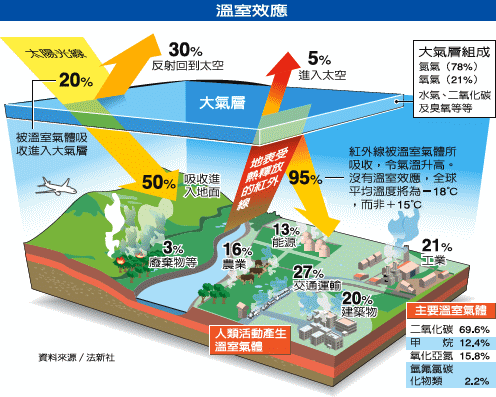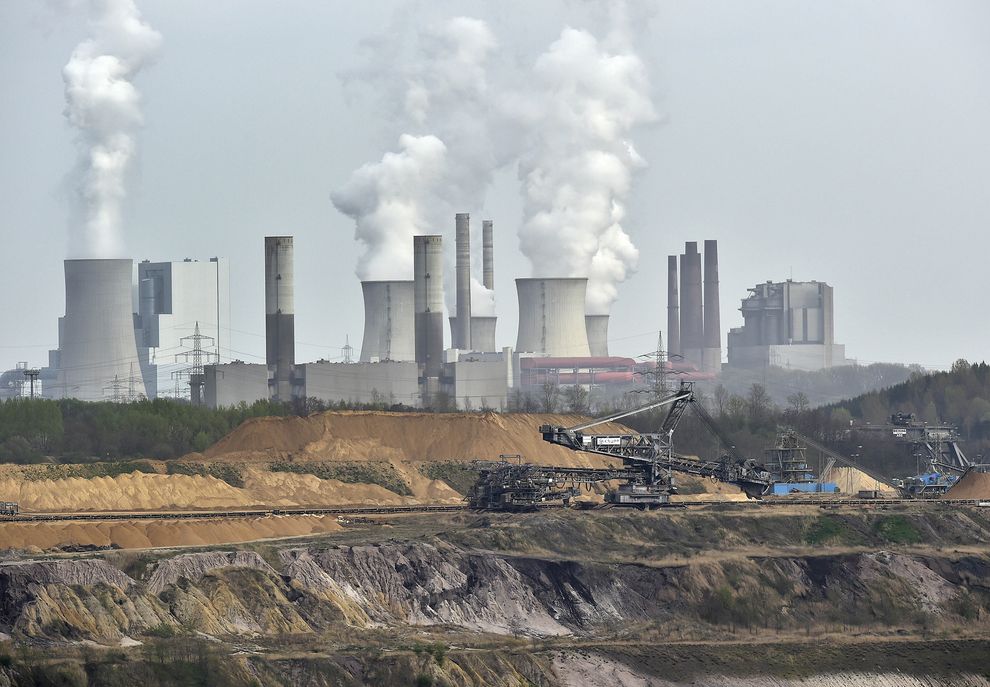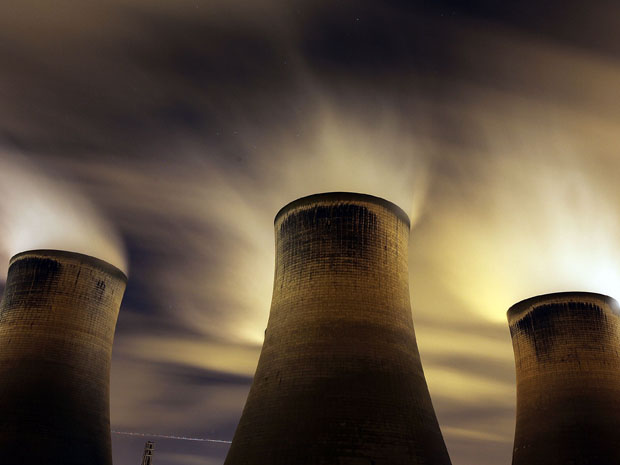現在位置:能源 > 廢核能的結果是大量燒炭,增加溫室效應
|
廢核能的結果是大量燒炭,增加溫室效應
溫室效應 溫室效應 (Green House Effect)是指星球的大氣層透過捕捉輻射使不同部份地區的氣溫相對穩定的效應。不少研究指出,人為因素使地球上的溫室效應加強,而造成全球暖化的效應。 1909年美國物理學家伍德分別用岩鹽(對長短波輻射都透明,不會截留長波輻射)和玻璃(有透過短波輻射而截留長波輻射的能力)做成溫室(花房)試驗,結果兩個溫室內的溫度一樣高。這表明溫室的保溫作用,主要不取決於是否阻截或吸收長波輻射,而在於其玻璃或岩鹽壁阻止室內(暖)外(冷)空氣對流或湍流方式的熱交換。 原理 太陽輻射主要是短波輻射,而地面輻射和大氣輻射則是長波輻射。大氣對長波輻射的吸收力較強,對短波輻射的吸收力較弱。 白天:太陽光照射到地球上,部分能量被大氣吸收,部分被反射回宇宙,大約47%的能量被地球表面吸收 夜晚:晚上地球表面以紅外線的方式向宇宙散發白天吸收的熱量,其中也有部分被大氣吸收 大氣層如同覆蓋玻璃的溫室一樣,保存了一定的熱量,使得地球不至於像沒有大氣層的月球一樣,被太陽照射時溫度急劇升高,不受太陽照射時溫度急劇下降。一些理論認為,由於溫室氣體的增加,使地球整體所保留的熱能增加,導致全球暖化。 影響 如果沒有溫室效應,地球就會冷得不適合人類居住。據估計,如果沒有大氣層,地球表面平均溫度會是−18℃。[1]正是有了溫室效應,使地球平均溫度維持在15℃,然而當下過多的溫室氣體導致地球平均溫度高於15℃。 目前,人類活動使大氣中溫室氣體含量增加,由於燃燒化石燃料及水蒸氣、二氧化碳、甲烷、及氟氯碳化物等產生排放的氣體,經紅外線輻射吸收留住能量,導致全球表面溫度升高[2],加劇溫室效應,造成全球暖化。為了解決此問題,聯合國制定了氣候變化框架公約,控制溫室氣體的排放量,防止地球的溫度上升,影響生態和環境。 |
|
Greenhouse gases to rise in wake of nuclear phase out, says IEA economist
RTCC, 13 February 2012, 3:13 pm 經濟學人雜誌:日、德廢核結果…大量燒炭 聯合新聞網 編譯任中原 ╱報導 2014年4月22日 3:18 據經濟學人雜誌報導,自從日本三年前發生福島核電廠災變之後,日本及德國相繼訂定「廢核」政策;但結果卻是兩國大量「燒炭」,增加燃煤電廠的發電量,使二氧化碳及其他化學物質排放量增加,不但使「溫室效應」惡化,加速氣候變遷,而且燃煤電廠的輻射排放量比核電廠更高。 經濟學人以「何其不幸,煤炭將成未來燃料」為題指出,由於煤炭既便宜,又容易取得、運輸及燃燒;而且蘊藏豐富,以現在的消費量計算可以供人類使用109年。而且煤炭大部分都蘊藏在政治穩定的地區,並有許多可靠的賣家供客戶選擇。 其他燃料大都受到國家及卡特爾的干預;但使用這種燃料的產業,包括取暖、發電及冶金,都相當有力,因而能壓低價格。這種燃料曾經帶動工業革命,現在又讓一些貧窮國家有了致富的機會。 經濟學人指出,燃煤的確優點多多,但只有一項小問題,就是太髒。開礦、運輸、貯存及燃燒時都會產生大量廢物。不但地下礦坑令勞工無法忍受,而且工作環境危險;即使是在地表就能開採的煤礦,也會造成土壤流失及耗盡水源。運輸更會帶來嚴重的環保問題。 燃煤消耗量增加,使二氧化碳排放量激增,造成地球暖化與氣候變遷,海洋變酸;燃煤也產生二氧化硫,使建築物疏鬆,且傷害肺部;另外還會釋放出多種有毒化學物質。燃煤電廠釋放出的輻射物,基至超過核電廠;這些微小卻致命的物質。以單位發電量計算,燃煤電廠造成的死亡人數超過核電廠,更超過燃油電廠。 但貧窮同樣要人命,而且經濟成長減緩會讓政治人物付出代價。過去廿年來在環保上的努力,只使全球煤業稍稍節制。儘管美國頁岩天然氣空前繁榮,但據能源資訊局預估到2040年時,全美百分之廿二的發電量仍來自燃煤(目前26%)。國際能源總署(IEA)預估,如果各國不改變政策,到二○一七年全球燃煤的重要性將趕上石油。中國雖因為逐漸富裕,開始抑制燃煤用量,但如印度及非洲國家正彌補空缺。 另外美國的天然氣熱潮,也迫使煤礦業者對外尋找新市場,全球煤價因而重挫。目前德國燃煤電廠的平均發電成本只有天然氣電廠的一半。在這個最重視綠能的歐洲國家,燃煤卻大行其道,實屬矛盾;德國用骯髒卻便宜的褐煤所產生的電量達1620億度,是兩德統一以來的最高峰。日本福島核災後,也轉用燃煤發電,政府四月十一日通過的新能源計畫更加重燃煤在長期電力供應上的地位。 |
|
Renewables, nuclear should triple to save climate: UN panel By Alex Morales and Stefan Nicola, Bloomberg News | April 14, 2014 8:56 AM ET Nuclear energy will play a key role in a greener future, but so will conservation and the fallout from rising oil prices. Christopher Furlong / Getty Images -- Nuclear energy will play a key role in a greener future, but so will conservation and the fallout from rising oil prices.. The world needs to triple the energy it gets from renewables, nuclear reactors and power plants that use emissions-capture technology to avoid dangerous levels of global warming, United Nations scientists said. Investments needed to keep climate change within safe limits would shave a fraction of a percent off annual global growth, the UN said yesterday in the third part of its most comprehensive study on warming. A delay in stemming rising greenhouse gases will cut chances to limit the global temperature increase, add to costs and lead to increasingly reliance on unproven technologies, they said. “The longer we wait to implement climate policy, the more risky the options we’ll have to take,” Ottmar Edenhofer, a co- chair of the 235 scientists who drafted the report, said in a phone interview from Berlin. “We need to depart from business as usual, and this departure is a huge technological and institutional challenge.” The UN said governments must accelerate efforts to build wind farms and solar parks and provide incentives to develop carbon capture and storage technology, or CCS, for fossil-fuel plants by making it more costly to emit carbon. The study aims to guide envoys from 194 nations next year as they devise a new accord to slash greenhouse gases. The researchers said emissions growth accelerated to an average of 2.2 percent a year for the 2000-2010 period from an annual 1.3 percent the preceding three decades. That puts in jeopardy the target agreed upon by climate treaty negotiators to stabilize warming since pre-industrial times to below 2 degrees Celsius (3.6 degrees Fahrenheit). ‘Too Long’ The possible situation in 2100 is “either you’ll have some fossil-fuel power generation with carbon capture and storage, or a complete switchover to renewables and smart energy storage,” Jonathan Grant, director of climate change at consultants PwC in London, said by phone. “The problem with some of those scenarios is the transition takes too long.” Global greenhouse gas emissions would have to be lowered between 40 percent and 70 percent by mid-century from 2010 levels, and to “near-zero” by the end of the century, efforts that would be likely to limit warming to 2 degrees Celsius, the UN Intergovernmental Panel on Climate Change said yesterday in a statement handed out in Berlin. Without extra effort to cut greenhouse gases, current trends may triple their concentration in the atmosphere this century, pushing warming since 1750 from 3.7 degrees Celsius to 4.8 degrees Celsius, according to the report. That would raise the risk of melting glaciers and sea ice, lengthening droughts and heatwaves and intensifying storms and flooding. ‘Unprecedented’ Cooperation “This report brings out the need for an unprecedented level of international cooperation,” Rajendra Pachauri, chairman of the IPCC, told reporters in Berlin. The assessment by the IPCC is intended as a reference for officials around the world as they devise emissions-curbing policies. Hundreds of scientists and government officials have spent the past week in Berlin editing a draft line-by-line to put it into clearer wording understandable to policy makers. When the panel finished its last study seven years ago, it was rewarded with the Nobel Peace Prize and the prospect its findings might spur a globally binding treaty to cut greenhouse gases. That deal hasn’t yet materialized, and the scientists were criticized for inaccuracies in their work and the content of leaked e-mails between climate researchers. Health Benefits The new report says measures to cut emissions may cost as much as 4 percent of global consumption in 2030 and 11 percent in 2100, in line with figures included in a draft report that was leaked in January. The figures don’t include benefits of the expenditure, such as better health due to improved air quality. Countries including the U.S. and the U.K. said the cost numbers risked skewing the data and lending support to those skeptical of spending money to tackle climate change. To allay those concerns, the researchers added language to show the costs are the cumulative effect of shaving about 0.06 percentage points off annual consumption growth that’s projected to be 1.6 percent to 3 percent. “This report is a wake-up call about global economic opportunity we can seize today as we lead on climate change,” U.S. Secretary of State John Kerry said in an e-mailed statement. Power Investment The International Energy Agency estimated last year that the power industry needs to invest $17 trillion from 2013 through 2035 to satisfy rising electricity demand. Investments made now in new fossil fuel-fired plants have implications for future emissions because they last for decades, it says. “After the boom of coal in the last decade, the 21st century is now the century of renewable energies,” Martin Kaiser, climate policy analyst at the environmental group Greenpeace, said in an interview. “That means a transition period of 20 to 30 years. That has to be organized and has to come quickly.” To meet the 2-degree goal, annual spending on fossil fuel plants must drop by $30 billion a year by 2030, the panel said. Annual expenditure on renewables, nuclear, and carbon capture and storage must rise by $147 billion, and spending on energy efficiency measures for transportation, buildings and industry needs to increase by $336 billion, it said. Industry Boon “Substantial reductions in emissions would require large changes in investment patterns,” the scientists wrote. A 2- degree scenario would involve “more rapid improvements of energy efficiency, a tripling to nearly a quadrupling of the share of zero- and low-carbon energy supply” by 2050. That finding is a boon to wind turbine makers such as Vestas Wind Systems A/S, solar panel manufacturers including Yingli Green Energy Holding Co. and nuclear reactor makers Areva SA and Toshiba Corp.’s Westinghouse unit. Existing emissions pledges by nations that are working toward a new international deal on climate change aren’t enough to meet the temperature target in the most cost-effective way, the scientists said. The longer we delay in reducing emissions, the more reliant we’ll be on carbon capture, a relatively unproven technology, they said. CCS has been installed on an industrial scale in 12 facilities worldwide, none of them in power stations, according to the Global CCS Institute in Melbourne, Australia. Injecting CO2 Operational plants include Statoil ASA’s Sleipner project, in which carbon dioxide, or CO2, is siphoned out of natural gas and injected into saline aquifers, and a program at a Koch Nitrogen Co. fertilizer plant in Oklahoma that pipes CO2 to oil fields for enhanced oil recovery. Southern Co.’s Kemper project in Mississippi and a SaskPower International Inc. project in Saskatchewan, Canada, are set this year to become the first two power stations equipped with CCS. Governments need to bring in policies that boost the cost of emitting carbon to a level that make CCS “economic,” Michael Grubb, chair of the Cambridge Centre for Climate Change Mitigation Research at the University of Cambridge, said in a phone interview. He put the level at more than 50 euros ($69) per ton. Allowances currently trade at about 5 euros on the European Union emissions trading system, the world’s biggest. Edenhofer, chief economist at the Potsdam Institute for Climate Impact Research in Germany, said CCS will be “indispensable,” as will its combination with bioenergy, which in theory will lead to negative emissions. That’s because the plants grown to fuel a biomass-fired power plant suck CO2 out of the atmosphere, while the CCS equipment would pipe the plant’s emissions for permanent underground storage. Behavioral Changes Other emissions-cutting tools identified by the panel include energy-saving measures for buildings such as insulation, more efficient machinery for factories and stricter fuel standards for vehicles. Behavioral changes were also deemed a “key mitigation strategy.” Those could include changing modes of transportation, altering diets and cutting food waste, they said. “The cost of averting catastrophic climate change is minimal, but in order to keep costs down, we have to act now,” said Samantha Smith, who leads the climate program at the environmental group WWF. “It is going to take coordinated efforts and it can’t be done by individual countries, companies or individuals each doing their very best.” (Bloomberg News) |



